-
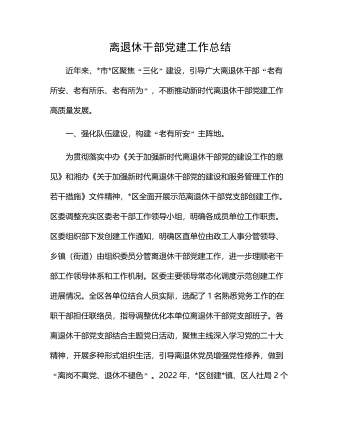
民族中学2023年体育工作开展情况总结
针对我校实情我们克服了场地小、器材少、上课班级人数多的众多不利因素,体育组制订了体育教师场地器材安排表,体育教师出操安全值勤表,从思想上组织上确保安全措施责任到人。教学过程中杜绝安全事故的发生。六、多方努力,齐抓共管,做好《学生体质健康标准》的测试、登记、上报工作《学生体质健康标准》是促进学生体质健康发展、激励学生积极进行身体锻炼的教育手段,是学生体质健康的个体评价标准,是《国家体育锻炼标准》在学校的具体实施,也是学生毕业的基本条件之一。为顺利完成学年度体育《标准》测试工作,提高我校体育《标准》成绩,学校在初期就制定了学校《体质健康标准》测试计划,要求各班级认真开展《标准》的训练和测试工作。在副校长xx的领导下,由体育组组长牵头,多方努力,齐抓共管,共同组织实施,高要求、高质量地完成了《学生体质健康标准》的测试、登记、数据录入及上报工作。
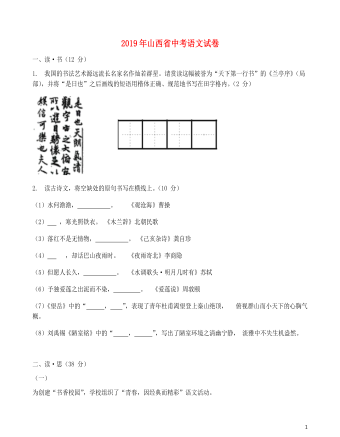
山西省2019年中考语文真题试题
黄花梨是极其名贵的木材,是制作高档家具的上好材料,有“鬼脸”的黄花梨更是其中的佼佼者,被视为佳品中的珍品,价值连城,受到世人的追捧。 其实,所谓“鬼脸”就是黄花梨受到伤害之后留下的疤。因为黄花梨生长于沿海地区,常遭台风袭击, 在风雨飘摇中不是被扭曲,就是被折弯,甚至被折断。尽管如此,也阻挡不了黄花梨的成长,只不过,为了弥补伤害,受伤处的纹理发生了变化,形成了各种各样惟妙惟肖的图形,有的像动物,有的像植物,有的像人物,形态各异,丰富多彩,形象逼真,十分迷人。
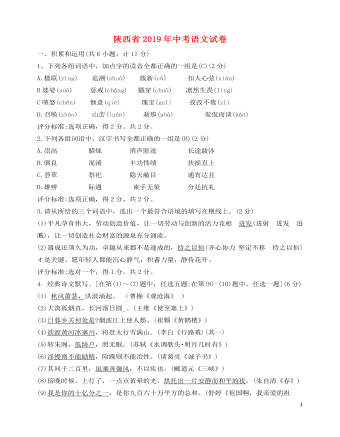
陕西省2019年中考语文真题试题
一般人在一个完整的夜间睡眠中,大脑在进行着具有一定周期性的功能和状态循环。依据多导睡眠图描绘的脑电图模式、眼动和肌张力特征,人的睡眠结构可以分为两种类型:非快速眼动睡眠和快速眼动睡眠。非快速眼动睡眠与快速眼动睡眠循环交替一次称为一个睡眠周期。每次夜晚的睡眠通常有4~5个睡眠周期,每个周期约90~110分钟。两个睡眠周期之间通常伴有短暂觉醒,整夜大概出现4~6次。
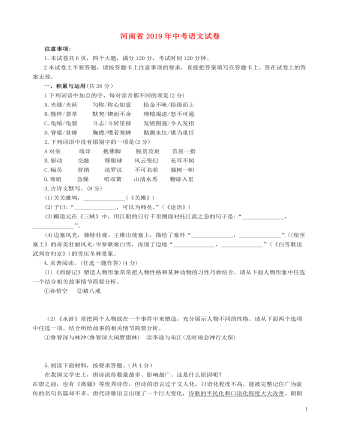
河南省2019年中考语文真题试题
做一粒“读书种子”,让阅读成为一种力量,推动文化传统薪火相传,可以说正是读书人的自我期许。从“每有会意,便欣然忘食”的陶渊明,到“读书破万卷,下笔如有神”的杜甫,再到“不是老夫朝不食,半山绝句当朝餐”的杨万里,无不是“读书种子”的精彩写照。读书滋养美好心灵,可以遇见更好的自己,看到更美的世界。所谓“耕读传家久,诗书继世长”,重视学习、重视诗书,千百年来融入中国人的血脉里,成为中国特有的文化禀赋。
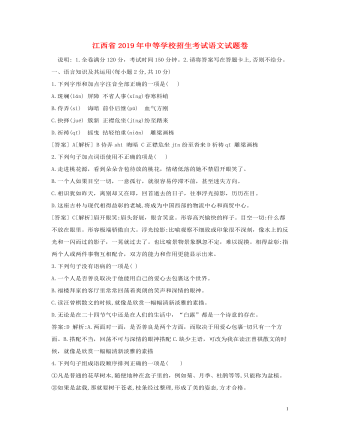
江西省2019年中考语文真题试题
人,说着就会慢慢儿长大的。坡里移来的小桃树,在菜园里都长满了-握。姐姐出阁了呢。那远远的山庄里,土财主。每次搬回来住娘家,母亲和我们弟弟,总是于夕阳的辉照中,在庄头眺望的。远远听见了銮铃声响,隔着疏疏的杨柳,隐约望见了在马上招手的客人,母亲总禁不住先喜欢得落泪,我们也快活得像几只鸟,叫着跑着迎上去。问着好,从伙计的手中接过马辔来,姐姐总说:“又长高了。”车门口,也是彼此问着好:客人尽管是一-边笑着,偷回首却是满手帕的泪。
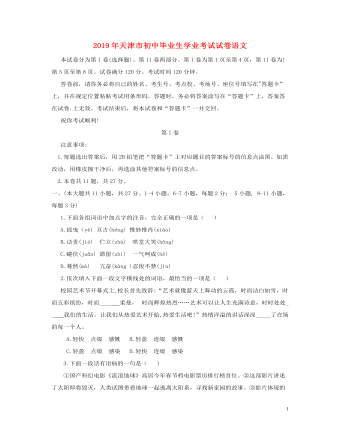
天津市2019年中考语文真题试题
从促进生物多样性的角度来说,啄木鸟发挥着重要的积极作用。啄木鸟属于初级洞巢鸟,自己开凿树洞并在洞内繁殖。同时,还为次级洞巢鸟(指没有啄洞本领,需要利用啄木鸟的旧洞进行繁殖的鸟类)提供“住所”。例如猫头鹰和大山雀,它们很多时候就需要利用啄木鸟的旧洞进行繁殖。如果某区域没有初级洞巢鸟,那么次级洞巢鸟也很可能消失。不仅如此,啄木鸟的啄洞还能为花鼠、貂等哺乳动物提供繁殖栖息场所。可以说,啄木鸟在整个森林生态系统的群落组织方面发挥着举足轻重的作用,是名副其实的“基石”物种。
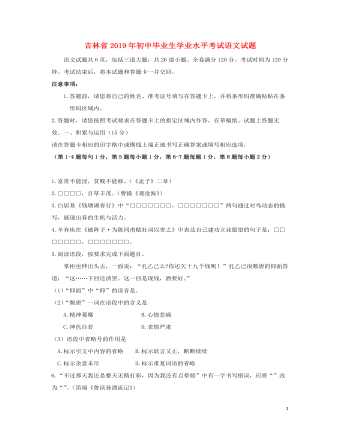
吉林省2019年中考语文真题试题
仪式过后,撤去供案,开炉放铁水。照眼的铁水倾入一个方形的火砖煲中。铁水盛满,便被两个大汉快速抬到广场中央。同时拿上来一个大铁桶,水里泡放着十几个长柄勺子,先是其中一个大汉走上去从铁桶中拿起一个勺子,走到火红的铁水前,弯腰一舀,跟着甩腰抡臂,满满一勺明亮的铁水泼在城墙上。就在这一瞬,好似天崩地裂,呈现出任何地方都不会见到的极其灿烂的奇观!金红的铁水泼击墙面,四外飞溅,就像整个城墙被炸开那样,整个堡门连同上边的门楼子都被照亮。由于铁硬墙坚,铁花飞得又高又远,铺天盖地,然后如同细密的光雨闪闪烁烁由天而降。可是不等这光雨落下,打树花的大汉又把第二勺铁水泼上去。一片冲天的火炮轰上去,一片漫天的光雨落下来,接续不断;每个大汉泼七八下后走下去,跟着另一位大汉上阵来。每个汉子的经验和功夫不同,手法上各有绝招,又互不示弱,渐渐就较上劲儿了。只要一较劲,打树花就更好看了。众人眼尖,不久就看出一位年纪大的汉子,身材短粗敦实,泼铁水时腰板像硬橡胶,一舀一舀泼起来又快又猛又有韵律,铁水泼得高,散的面广,而且正好绕过城门洞;铁花升腾时如在头上张开一棵辉煌又奇幻的大树。每每泼完铁水走下来时,身后边的光雨哗哗地落着,映衬着他一条粗健的黑影,好像枪林弹雨中一个无畏的勇士。他的装束也有特色。别人头上的草帽都是有檐的,为了防止铁水迸在脸上,惟有他戴的是一顶无檐的小毡帽,更显出他的勇气。
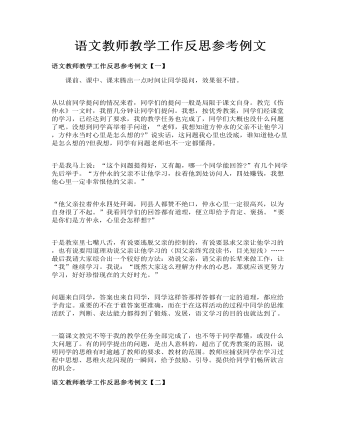
语文教师教学工作反思参考例文
于是我马上说:“这个问题提得好,又有趣,哪一个同学能回答?”有几个同学先后举手。“方仲永的父亲不让他学习,拉着他到处访问人,四处赚钱,我想他心里一定非常恨他的父亲。” “他父亲拉着仲永四处拜谒,同县人都赞不绝口,仲永心里一定很高兴,以为自身很了不起。”我看同学们的回答都有道理,便立即给予肯定、褒扬。“要是你们是方仲永,心里会怎样想?”
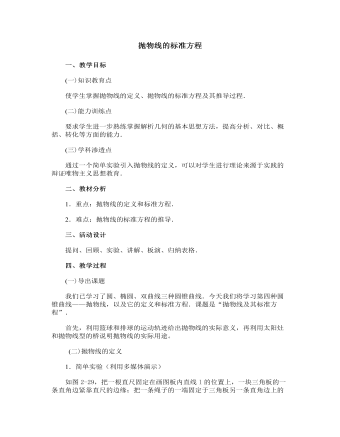
【高教版】中职数学拓展模块:2.3《抛物线》教学设计
一、教学目标(一)知识教育点使学生掌握抛物线的定义、抛物线的标准方程及其推导过程.(二)能力训练点要求学生进一步熟练掌握解析几何的基本思想方法,提高分析、对比、概括、转化等方面的能力.(三)学科渗透点通过一个简单实验引入抛物线的定义,可以对学生进行理论来源于实践的辩证唯物主义思想教育.二、教材分析1.重点:抛物线的定义和标准方程.2.难点:抛物线的标准方程的推导.三、活动设计提问、回顾、实验、讲解、板演、归纳表格.四、教学过程(一)导出课题我们已学习了圆、椭圆、双曲线三种圆锥曲线.今天我们将学习第四种圆锥曲线——抛物线,以及它的定义和标准方程.课题是“抛物线及其标准方程”.首先,利用篮球和排球的运动轨迹给出抛物线的实际意义,再利用太阳灶和抛物线型的桥说明抛物线的实际用途。
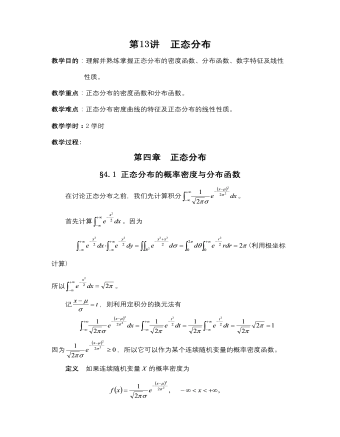
【高教版】中职数学拓展模块:3.5《正态分布》教学设计
教学目的:理解并熟练掌握正态分布的密度函数、分布函数、数字特征及线性性质。教学重点:正态分布的密度函数和分布函数。教学难点:正态分布密度曲线的特征及正态分布的线性性质。教学学时:2学时教学过程:第四章 正态分布§4.1 正态分布的概率密度与分布函数在讨论正态分布之前,我们先计算积分。首先计算。因为(利用极坐标计算)所以。记,则利用定积分的换元法有因为,所以它可以作为某个连续随机变量的概率密度函数。定义 如果连续随机变量的概率密度为则称随机变量服从正态分布,记作,其中是正态分布的参数。正态分布也称为高斯(Gauss)分布。

【高教版】中职数学拓展模块:2.2《双曲线》教学设计
教学准备 1. 教学目标 知识与技能掌握双曲线的定义,掌握双曲线的四种标准方程形式及其对应的焦点、准线.过程与方法掌握对双曲线标准方程的推导,进一步理解求曲线方程的方法——坐标法.通过本节课的学习,提高学生观察、类比、分析和概括的能力.情感、态度与价值观通过本节的学习,体验研究解析几何的基本思想,感受圆锥曲线在刻画现实和解决实际问题中的作用,进一步体会数形结合的思想.2. 教学重点/难点 教学重点双曲线的定义及焦点及双曲线标准方程.教学难点在推导双曲线标准方程的过程中,如何选择适当的坐标系. 3. 教学用具 多媒体4. 标签
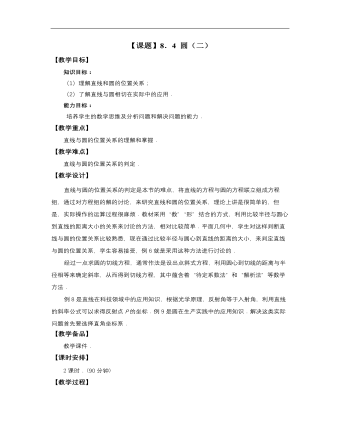
高教版中职数学基础模块下册:8.4《圆》教学设计
教 学 过 程教师 行为学生 行为教学 意图时间 *揭示课题 8.4 圆(二) *创设情境 兴趣导入 【知识回顾】 我们知道,平面内直线与圆的位置关系有三种(如图8-21): (1)相离:无交点; (2)相切:仅有一个交点; (3)相交:有两个交点. 并且知道,直线与圆的位置关系,可以由圆心到直线的距离d与半径r的关系来判别(如图8-22): (1):直线与圆相离; (2):直线与圆相切; (3):直线与圆相交. 介绍 讲解 说明 质疑 引导 分析 了解 思考 思考 带领 学生 分析 启发 学生思考 0 15*动脑思考 探索新知 【新知识】 设圆的标准方程为 , 则圆心C(a,b)到直线的距离为 . 比较d与r的大小,就可以判断直线与圆的位置关系. 讲解 说明 引领 分析 思考 理解 带领 学生 分析 30*巩固知识 典型例题 【知识巩固】 例6 判断下列各直线与圆的位置关系: ⑴直线, 圆; ⑵直线,圆. 解 ⑴ 由方程知,圆C的半径,圆心为. 圆心C到直线的距离为 , 由于,故直线与圆相交. ⑵ 将方程化成圆的标准方程,得 . 因此,圆心为,半径.圆心C到直线的距离为 , 即由于,所以直线与圆相交. 【想一想】 你是否可以找到判断直线与圆的位置关系的其他方法? *例7 过点作圆的切线,试求切线方程. 分析 求切线方程的关键是求出切线的斜率.可以利用原点到切线的距离等于半径的条件来确定. 解 设所求切线的斜率为,则切线方程为 , 即 . 圆的标准方程为 , 所以圆心,半径. 图8-23 圆心到切线的距离为 , 由于圆心到切线的距离与半径相等,所以 , 解得 . 故所求切线方程(如图8-23)为 , 即 或. 说明 例题7中所使用的方法是待定系数法,在利用代数方法研究几何问题中有着广泛的应用. 【想一想】 能否利用“切线垂直于过切点的半径”的几何性质求出切线方程? 说明 强调 引领 讲解 说明 引领 讲解 说明 观察 思考 主动 求解 思考 主动 求解 通过例题进一步领会 注意 观察 学生 是否 理解 知识 点 50
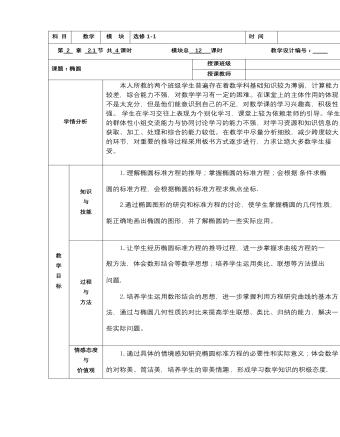
【高教版】中职数学拓展模块:2.1《椭圆》优秀教学设计
本人所教的两个班级学生普遍存在着数学科基础知识较为薄弱,计算能力较差,综合能力不强,对数学学习有一定的困难。在课堂上的主体作用的体现不是太充分,但是他们能意识到自己的不足,对数学课的学习兴趣高,积极性强。 学生在学习交往上表现为个别化学习,课堂上较为依赖老师的引导。学生的群体性小组交流能力与协同讨论学习的能力不强,对学习资源和知识信息的获取、加工、处理和综合的能力较低。在教学中尽量分析细致,减少跨度较大的环节,对重要的推导过程采用板书方式逐步进行,力求让绝大多数学生接受。 1.理解椭圆标准方程的推导;掌握椭圆的标准方程;会根据条件求椭圆的标准方程,会根据椭圆的标准方程求焦点坐标. 2.通过椭圆图形的研究和标准方程的讨论,使学生掌握椭圆的几何性质,能正确地画出椭圆的图形,并了解椭圆的一些实际应用。 1.让学生经历椭圆标准方程的推导过程,进一步掌握求曲线方程的一般方法,体会数形结合等数学思想;培养学生运用类比、联想等方法提出问题. 2.培养学生运用数形结合的思想,进一步掌握利用方程研究曲线的基本方法,通过与椭圆几何性质的对比来提高学生联想、类比、归纳的能力,解决一些实际问题。 1.通过具体的情境感知研究椭圆标准方程的必要性和实际意义;体会数学的对称美、简洁美,培养学生的审美情趣,形成学习数学知识的积极态度. 2.进一步理解并掌握代数知识在解析几何运算中的作用,提高解方程组和计算能力,通过“数”研究“形”,说明“数”与“形”存在矛盾的统一体中,通过“数”的变化研究“形”的本质。帮助学生建立勇于探索创新的精神和克服困难的信心。

新人教版高中英语必修3Unit 2 Morals and Virtues教学设计二
Activity 41. Students complete the task of activity 4, then teachers and students check the answers. 2. The teacher organized the students to work together and asked them to use the tables and mind maps sorted out before to retold the important choices in Lin Qiaozhi's life and their resultsStep 5 Language points1. The teacher asks the students to read the text carefully, find out the core words and long and difficult sentences in the text and draw lines, understand the use of vocabulary, and analyze the structure of long and difficult sentences. 2. The teacher explains and summarizes the usage of core vocabulary and asks the students to take notes. 3. The teacher analyzes and explains the long and difficult sentences that the students don't understand, so that the students can understand them better. Step 6 Homework1. Read the text again, in-depth understanding of the text; 2. Master the use of core vocabulary and understand the long and difficult sentences. 3. Complete relevant exercises in the guide plan. 1、通过本节内容学习,学生是否理解和掌握阅读文本中的新词汇的意义与用法;2、通过本节内容学习,学生能否结合文本特点总结林巧稚的人生原则和人格品质特征;3、通过本节内容学习,学生能否针对人生抉择发表自己的看法;能否全面地、客观地、理性地看待问题,进而对道德和人性有更加深入的思考和理解。

新人教版高中英语必修3Unit 2 Morals and Virtues教学设计三
The joke set her crying.这个玩笑使她哭起来。Step 5 ReadingActivity 31. Students read the small text in activity 3. The teacher provides several small questions to check whether students understand the content of the text and the ideographic function of the -ing form in the text.*Where are those people?*Why did Dr Bethune come to China?*How did he help the Chinese people during the war?*What did Chairman Mao Zedong say about him?2. Ss try to rewrite some sentences using the -ing form. Then check the answers. When checking the answers, the teacher can ask different students to read the rewritten sentences and give comments.Answers:1. he became very interested in medicine, deciding to become a doctor.2. …after hearing that many people were dying in the war.3. Helping to organise hospitals, he taught doctors and nurses, and showed people how to give first aid./ He helped to organise hospitals, teaching doctors and nurses, and showing people how to give first aid.4. …praising Dr Bethune as a hero to be remembered in China.Step 6 PracticeActivity 4Students complete grammar activities 2 and 3 on page 69 of the workbook.Step 6 Homework1. Understand and master the functions and usage of the -ing form;2. Finish the other exercises in Using structures.1、通过本节内容学习,学生是否理解和掌握动词-ing形式作宾语补足语语和状语语的功能和意义;2、通过本节内容学习,学生能否正确使用动词-ing形式描述人物的行为、动作及其经历;3、通过本节内容学习,学生能否独立完成练习册和导学案中的相关练习。

新人教版高中英语必修3Unit 2 Morals and Virtues教学设计四
3.Teachers ask different groups to report the answers to the questions and ask them to try different sentence patterns.The teacher added some sentence patterns for students to refer to when writing.Step 4 Writing taskActivity 51.Write the first draft.Students first review the evaluation criteria in activity 5, and then independently complete the draft according to the outline of activity 4, the answers to the questions listed in the group discussion and report, and the reference sentence pattern.2.Change partners.The teacher guides the students to evaluate their partner's composition according to the checklist of activity 5 and proposes Suggestions for modification.3.Finalize the draft.Based on the peer evaluation, students revise their own compositions and determine the final draft.Finally, through group recommendation, the teacher selects excellent compositions for projection display or reading aloud in class, and gives comments and Suggestions.Step 5 Showing writingActivity 5T call some Ss to share their writing.Step 6 Homework1. Read the passage in this section to better understand the passage.2. Carefully understand the hierarchical structure of the article, and deeply understand the plot of the story according to the causes, process and results;3. Independently complete the relevant exercises in the guide plan.1、通过本节内容学习,学生是否理解和掌握阅读文本中的新词汇的意义与用法;2、通过本节内容学习,学生能否通过人物言行的对比分析道德故事的深层内涵;3、通过本节内容学习,学生能否根据故事的起因、经过和结果来深入理解故事的情节,从而了解文章的层次结构;4、结合现实生活案例发表自己的见解和看法,写一篇观点明确、层次分明的故事评论。

新人教版高中英语必修3Unit 2 Morals and virtues教学设计一
(2) students are divided into groups according to the requirements of activity 3. Each student shares a story of personal experience or hearing-witnessing kindness, and then selects the most touching story in the group and shares it with the whole class. Before the students share the story, the teacher can instruct them to use the words and sentence patterns in the box to express. For example, the words in the box can be classified:Time order: first of all, then, after that, later, finally logical relationship :so, however, although, butTeachers can also appropriately add some transitional language to enrich students' expression:Afterwards, afterwards, at last, in the end, eventuallySpatial order: next to, far from, on the left, in front ofOtherwise, nevertheless, as a result, therefore, furthermore, in addition, as well asSummary: in a word, in short, on the whole, to sum up, in briefStep 8 Homework1. Understand the definition of "moral dilemma" and establish a correct moral view;2. Accumulate vocabulary about attitudes and emotions in listening texts and use them to express your own views;3. Complete relevant exercises in the guide plan.1、通过本节内容学习,学生能否理解理解“道德困境”的定义;2、通过本节内容学习,学生能否通过说话人所表达的内容、说话的语气、语调等来判断其态度和情绪;3、通过本节内容学习,学生能否针对具体的道德困境发表自己的看法和见解,能否掌握听力理训练中的听力策略。

新人教版高中英语必修3Unit 3 Diverse Cultures教学设计三
The price is the same as(the price was)before the war.价格与战前相同。(4)定语从句中的“关系代词+助动词be”可以省略。The ticket(that/which was)booked by his sister has been sent to him.他妹妹订的那张票已送到了他那里。Step 5 PracticeActivity 3(1) Guide students to complete the four activities in the Using Structures part of exercise book, in which activities 1 and 2 focus on ellipsis in dialogue answers, activity 3 focus on signs and headlines, two typical situations where ellipsis is used, and activity 4 focus on ellipsis in diary, an informal style.(2) Combine the examples in the above activities, ask students to summarize the omitted situations in groups, and make their own summary into a poster, and post it on the class wall after class to share with the class.(This step should give full play to the subjectivity of students, and teachers should encourage students to conclude different ellipsis phenomena according to their own understanding, they can conclude according to the different parts omitted in the sentence.)Step 6 Homework1. Understand and master the usages of ellipsis;2. Finish the other exercises in Using structures of Workbook.1、通过本节内容学习,学生是否理解和掌握省略的用法;2、通过本节内容学习,学生能否根据上下文语境或情景恢复句子中省略的成分,体会使用省略的效果;3、通过本节内容学习,学生能否独立完成练习册和导学案中的相关练习。

新人教版高中英语必修3Unit 3 Diverse Cultures教学设计二
(2)Consolidate key vocabulary.Ask the students to complete the exercises of activity 6 by themselves. Then ask them to check the answers with their partners.(The first language:Damage of the 1906 San Francisco earthquake and fire.A second language: Yunnan - one of the most diverse provinces in China).Step 5 Language points1. The teacher asks the students to read the text carefully, find out the more words and long and difficult sentences in the text and draw lines, understand the use of vocabulary, and analyze the structure of long and difficult sentences.2. The teacher explains and summarizes the usage of core vocabulary and asks the students to take notes.3. The teacher analyzes and explains the long and difficult sentences that the students don't understand, so that the students can understand them better.Step 6 Homework1. Read the text again, in-depth understanding of the text;2. Master the use of core vocabulary and understand the long and difficult sentences.3. Complete relevant exercises in the guide plan.1、通过本节内容学习,学生是否理解和掌握阅读文本中的新词汇的意义与用法;2、通过本节内容学习,学生能否结合文本特点了解文章的结构和作者的写作逻辑;3、通过本节内容学习,学生能否了解旧金山的城市风貌、文化特色,以及加利福尼亚州的历史,体会多元文化对美国的影响。

新人教版高中英语必修3Unit 3 Diverse Cultures教学设计四
该板块的活动主题是“介绍一个有显著文化特征的地方”( Describe a place with distinctive cultural identity)。该板块通过介绍中国城继续聚焦中国文化。本单元主题图呈现的是旧金山中国城的典型景象, Reading and Thinking部分也提到中国城,为该板块作铺垫。介绍中国城的目的主要是体现中国文化与美国多元文化的关系,它是美国多元文化的重要组成部分。中国城也是海外华人的精神家园和传播中国文化的重要窗口,外国人在中国城能近距离体验中国文化。1. Read the text to understand the cultural characteristics of Chinatown in San Francisco and the relationship between Chinese culture and American multiculturalism;2. Through reading, learn to comb the main information of the article, understand the author's writing purpose and writing characteristics;3. Learn to give a comprehensive, accurate, and organized description of the city or town you live in;Learn to revise and evaluate your writing.Importance:1. Guide the students to read the introduction of Chinatown in San Francisco and grasp its writing characteristics;2. Guide students to introduce their city or town in a comprehensive, accurate and organized way;3. Learn to comb the main information of the article, understand the author's writing purpose, and master the core vocabulary.


